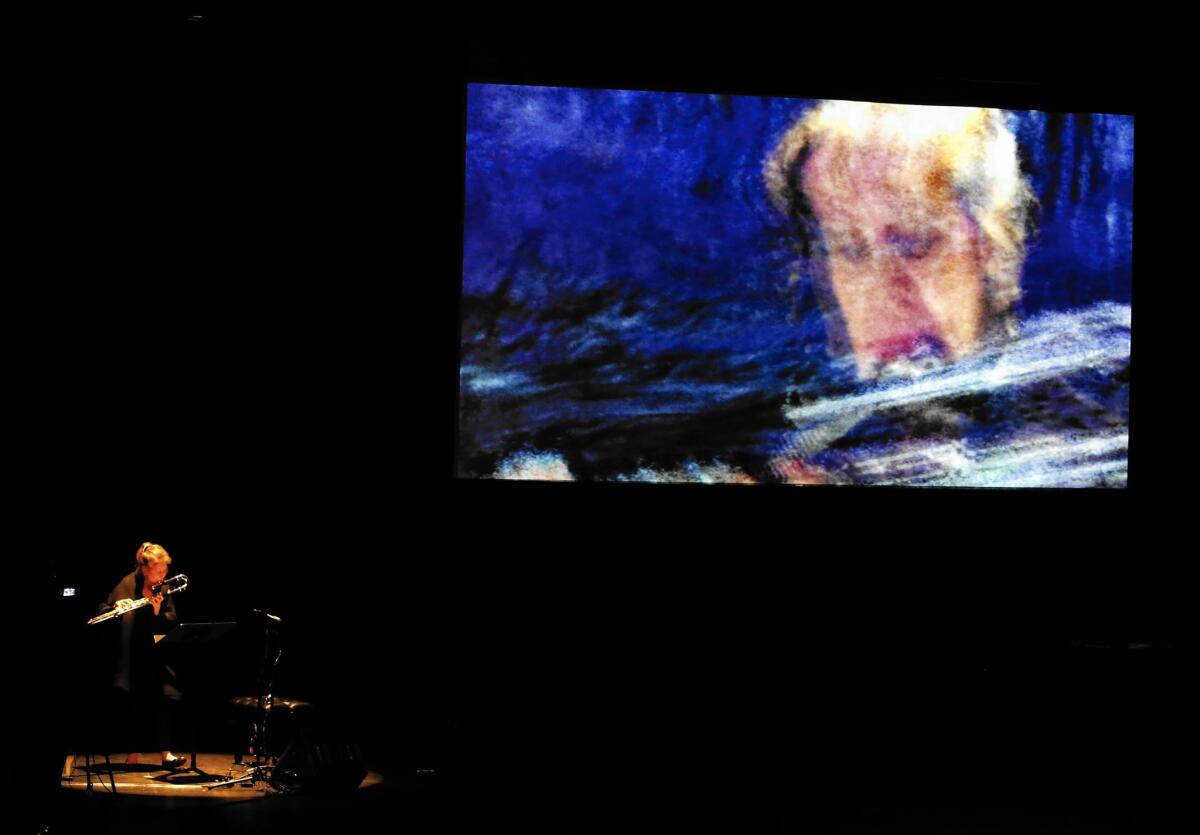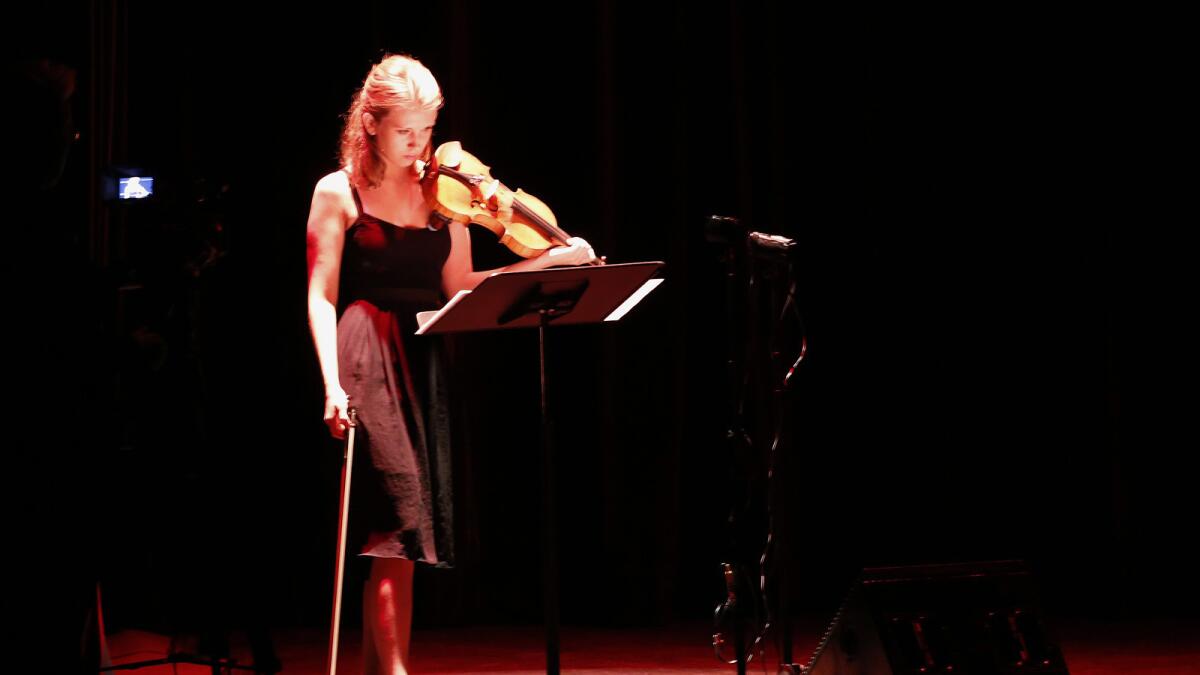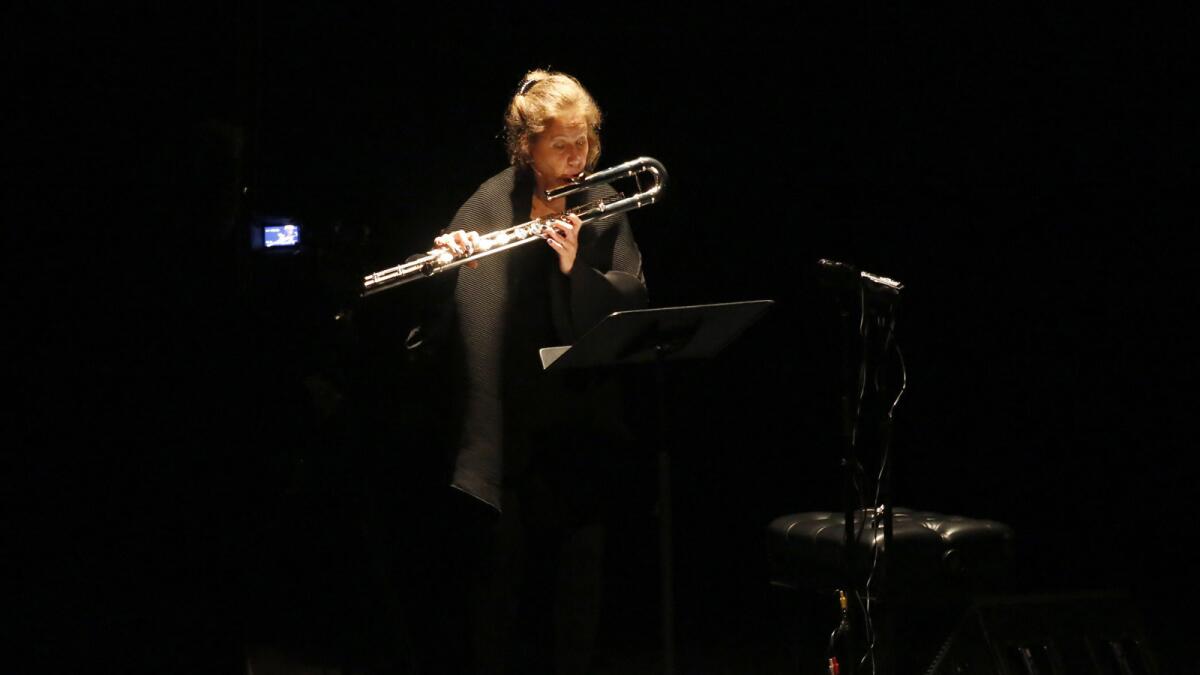Critic’s Notebook: Classical music + visuals = intrigue, at UCLA’s ‘Beyond Music’

Flutist Camilla Hoitenga performs as part of “A Visual Concert” at UCLA on Sunday night.
- Share via
How can the visual artist confront classical music? Kaija Saariaho and Jean-Baptiste Barrière are part of a UCLA event.
The urge to enhance music with something pictorial could easily go back to the dawn of humanity. Might not a prehistoric happening have consisted of one caveman hitting something resonant with a bone while another shot off sparks from a flint to illuminate cave paintings?
SIGN UP for the free Essential Arts & Culture newsletter >>
But the urgency to find a visual attraction to classical music feels rather more recent. A widely shared worry is that modern digital culture causes the visual element to be predominant. A teenager who considers YouTube a primary source of discovering music expects to see something.
UCLA spent the weekend mulling over all this with “Beyond Music: Composition + Performance in the Age of Augmented Reality.”
The centerpieces were a pair of concerts in Schoenberg Hall, one of music by the renowned Finnish composer Kaija Saariaho, and the other by her husband, Jean-Baptiste Barrière, a French composer and media artist. Barrière illuminated Saariaho’s music, but his own work was meant more for his particular brand of manipulating projections of a live performer on an overhead screen in a manner analogous to how he manipulates live and electronic sounds.

Parisian violinist Aliisa Neige Barriere performed a piece accompanied by one of Barriere’s Jean-Baptiste visual compositions.
In between were a pair of concerts for which outsiders came in and provided new visual context for mostly older music. A four-hour symposium put on by the UCLA Department of Design and Media Arts offered rationale and perspective.
There were essentially four ways suggested for a visual artist to confront classical music, beginning with Barrière’s interactive one. Another is to transform the space in which the music is performed through projections that alter one’s perception of space, place and, just maybe, sound.
This is what Refik Anadol did with an all-night performance of Erik Satie’s “Vexations,” in which UCLA students and faculty took turns playing hundreds of repetitions of a strange, short piano piece. Some listeners spread out mats on the floor of the Ostin Ensemble Room, a modern space with irregularly shaped walls on which were projected ever-changing swirling patterns.
A third approach was that of Candace Reckinger and Michael Patterson, experimental filmmakers with a background in music videos, whose approach is more illustrative. The audience in the Experimental Digital Arts Space was surrounded by three large screens, on which student performances of Bach and two contemporary pieces were decorated with a variety of moving designs, sometimes abstract and sometimes representative.
Reality was not really augmented in any of these. Nor were the spottily attended main concerts any kind of magnet for hoards of young people not on student assignments. The few pieces without added visuals — in particular a movement from Lou Harrison’s “Tributes to Charon,” with its alarm clocks as percussion instruments — did not lack stimulation.
The real question was what kind of information is most helpful to an audience. Saariaho creates a miraculous sense of suspended animation through her music all by itself. Barrière’s dreamlike visuals involved a camera operator shooting a live performer on stage, and then projections of the performer overhead in a new and changing environment. The mood was appropriate. But all the performances, those that used video and those that didn’t, were given a greatly darkened theater, where it was impossible to see the program and know what music was being played.

Flutist Camilla Hoitenga performs as part of “A Visual Concert” at UCLA on Sunday night.
I’m not sure the tradeoff was worth it, especially given how good the performances were. Pianist Gloria Cheng, whose inspiration the weekend was, altered as much reality as needed simply from the keyboard in her illuminating playing of Saariaho’s Prelude and Ballade. Movses Pogossian’s rapt, concentrated account of “Frises” revealed how violin and electronics alone can transform a Bach Chaconne far more radically than visuals can.
But it was also nice to be transported into Barrière’s mysterious visual realms with the percussion piece “Six Japanese Gardens” and his entrancing way with Nocturne (featuring Aliisa Barrière, his and the composer’s daughter).
Barrière’s music relies more heavily on electronics than does Saariaho’s. And he may have made a mistake beginning with “Chréode,” for four-channel tape, creating a compelling soundscape in a pitch-black hall with no visual help whatsoever. The rest of his evening was for performers, electronically and visually manipulated, but the visuals felt a little too much like those for Saariaho the night before to seem integral. His music had to do the real work, which it did most effectively in the weird use of bass flute and piccolo in “Crossing the Blind Forest” and the moments of rocking percussion in “Time Dusts.”
The other visual artist present was Bill Viola, who screened his 1994 video made to accompany Varèse’s “Déserts.” Here Viola creates an alternative universe that doesn’t so much enhance Varèse as save the composer from himself in his last, bleakly imposing evaluation through honking brass and winds intercut with toxic electronic sounds.
When a lighting bolt synchronizes with a Varèsian beat, Viola connects with the music just enough to tell you he knows the landscape. But when a man alone at a table falls, with his glass and book, in an excruciatingly beautiful slow motion — a visual equivalent of the floating quality of Saariaho’s music — Viola finds the calm Varèse needs. Here the rare role of the visual artist is not to augment music that doesn’t need augmenting but to finish music that desperately needs finishing.
ALSO:
‘Hopscotch’ moves around L.A. and sometimes transports
L.A. Phil and Semyon Bychkov achieve a musical summit with ‘Alpine Symphony’
‘The Poet in Exile’ at the Wallis lacks full picture of Walter Arlen
More to Read
The biggest entertainment stories
Get our big stories about Hollywood, film, television, music, arts, culture and more right in your inbox as soon as they publish.
You may occasionally receive promotional content from the Los Angeles Times.











